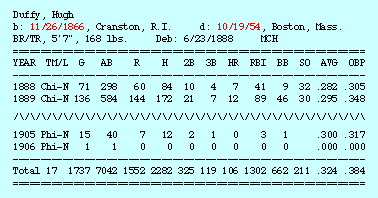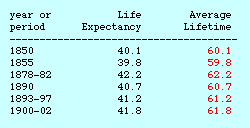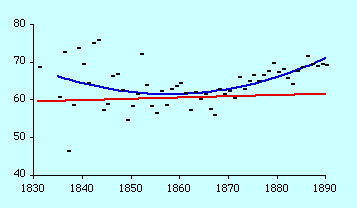|
Life Expectancy Among 19th Century Baseball Players Ed Stephan Total Baseball (John Thorn and Pete Palmer) consists of 2,362 pages, nearly all of them filled with statistical tables, and covering the careers of every player who ever played in the major leagues. From the first great baseball writer, Henry Chadwick (who invented most of the basic statistics still computed), to the complex formulas developed by today's "sabermetricians" (named after SABR, the Society for American Baseball Research), baseball is a great field for statistical analysis/argument. Beginning with the work of John Graunt (1620-74) and his early colleagues, the most fundamental statistic computed by demographers has been LIFE EXPECTANCY: the average number of years lived. The idea for this little essay began to form when the third edition of Total Baseball (1993) appeared in CD-ROM form, the mountains of data now accessible to computer analysis through compact disc. Each player was described with tables which look in part like this:
with the usual at bats AB, home runs HR, and batting averages AVG and somewhat stranger statistics such as PRO+ (On Base Percentage plus Slugging Average, normalized to league average and adjusted for home-park factor). DATA AND FINDINGS My focus lay in the headers above the tables. Hugh Duffy holds the highest AVG of all time (.440 set in 1894) and was almost 75 years old when he coached my hero Ted Williams (AVG =.406 in 1941). What interested me about Duffy here, however, were the statistics "b:11/26/1866" and "d:10/19/54". Accounting for month length and leap years, Duffy lived 1954.799 - 1866.903 = 87.896 years. That's a long time even today. What about men born in 1866? Problem: There is no national life expectancy data for the 19th century. In fact the birth-and-death registration area was not fully national until 1933. Historical Statistics of the United States: Colonial Times to 1970 (U.S. Bureau of the Census, 1975) only gives life expectancies for 19th century Massachusetts (by sex, for ages birth, 20, 40, 60 and 70). A male born in 1855 could expect a lifetime of 38.7 years. Life expectancy at age 20 was 39.8 years for a lifetime of 59.8 years, 21.1 years longer than expectancy at birth. The difference lay in the fact that Massachusetts' Infant Mortality Rate was 122.9 deaths per 1,000 live births (compared with 7.9 in 1988). I wanted to examine life expectancies for professional baseball players, so it seemed the proper reference was for those who had escaped the perils of infancy at that time, 20-year-old males. As you can see, their average lifetime changed little during the 19th century, rising only slightly from about 60 to less than 62 years:
For my analysis I chose all players born before 1891. I picked this cutoff date because I wanted to allow enough time for all those born to die (the data on the disc terminate in 1991). There were 3,517 players born before 1891. Of these there were 52 with unknown birthdates, 141 with no known death dates, and 276 with neither piece of information available. So the usable set was 3,048 professional ballplayers. The surprise came when I plotted dots for the average lifetimes of each cohort of professional ballplayers. The dots for the very early players were higher than standard, then dropped even with or below standard, then rose again. A second degree polynomial fitted to these data had the formula:
Lifetime = 32095.942 - 34.486(Year) + .009(Year)^2It is shown here as a blue line (dots are averages for each year of birth):
Relating the graph to what was happening in baseball requires shifting the axis about 20 years, the age around which most players made their debut (Hugh Duffy was 1888.477 - 1866.903 = 21.574 years of age at his debut). So the decline in life expectancy for those born 1830-50 is for those entering baseball approximately 1850-70. The "flat part" of the curve refers to those entering baseball 1870-90, and the rising part those entering 1890-1910. 19th CENTURY BASEBALL Much of what follows is common knowledge; many of the details are from D.Q. Voigt's three volume American Baseball: From the Gentleman's Sport to the Commissioner System . Baseball was never invented. It evolved from a number of different ball-and-stick games (paddle ball, trap ball, one-old-cat, rounders and town ball) originating in England. As early as the American Revolution Albigence Waldo, a surgeon with Washington's troops at Valley Forge, wrote of troops playing "base ball" in their free time. In 1845 Alexander Cartwright formalized the New York Knickerbockers' version of the game: a diamond shaped infield, with bases ninety feet apart, three-strikes-you're-out, batter out on a caught ball, three outs per inning, a nine-man team. The "New York game" spread rapidly, replacing earlier localized forms. By the 1860s newspapers regularly reported game results. From its beginnings, baseball was seen as a way of satisfying the recreational needs of an increasingly urban-industrial society. At its inception it was played by and for wealthy gentlemen. A club might consist of 40 members. The president would appoint two captains who would choose teams from among the members. Games were played Monday and Thursday afternoons, the losers often providing a lavish evening's entertainment for the winners. When inter-club games were arranged, by written invitations from their secretaries, demeanor was important. Some refused contests with rivals on the grounds they were ungentlemanly. Brooklyn's Excelsiors refused to play the Atlantics because they had been offended in 1860 by a vulgar crowd and loud-mouthed gamblers who harassed them during a game. But that is precisely how the game was changing during the 1850-70 period -- increasing commercialism (charging admission), under-the-table payments to exceptional players, and gambling on the outcome of games. By 1868 Chadwick wrote that a club "will have their regular professional ten," an "amateur first-nine, and their muffins" (by which he meant the gentlemenly duffers who once ran the game. Beginning with the first openly all-salaried team (Cincinnati's Red Stocking Club in 1869), the 1870-1890 period saw the complete professionalization of baseball. The National Association of Professional Baseball Players was formed in 1871. There were endless squabbles over ticket prices and division of gate receipts. Critics accused the players' league of failing to discipline contract jumpers, drunkards, and game fixers. Temperance unions proposed closing saloons at least when rowdy young ballplayers came to town. The National League of Professional Base Ball Clubs was formed in 1876, run by business-minded investors in joint-stock company clubs. The 1880s has been called Major League Baseball's "Golden Age." Profits soared, players salaries rose somewhat, a season of 84 games became one of 132, a weekly periodical "The Sporting News" came into being, wooden stadiums with double-deck stands replaced open fields, and the standard refreshment became hot dogs, soda pop and peanuts. In 1893 the pitcher's mound was moved from 45 feet to 60.5 feet from the plate. It took the pitchers some years to adjust to this and in the meantime an era of spectacular slugging opened. Signals and specialized player substitution were introduced. In 1900 the Western League based in the growing cities of the Midwest proclaimed itself the American League. Concrete and steel stadiums replaced often burned down wooden ones. A World Series between the leagues captured much public attention, "Take Me Out to the Ballgame" showed up in 1908, and attendance went from 4.7 million in 1903 to 10 million in 1911. CONCLUSION The common thread through this narrative, and the explanation for the fall-flat-rise of player lifetimes is money. Organized baseball was first played by the urban wealthy — amateurs, or literally: for love — and upper classes outlive lower classes. As clubs became money-making concerns they sought "ungentlemanly" players who could win, for a price. It's numbing to read about the many players in the 1870-90s who died in their twenties and thirties, often from alcohol and fighting. The game was being played, not for love but for money. By 1890-1910 baseball was becoming so important a business that owners and managers were beginning to confine players to hotels, enforcing curfews, fining those with liquor bottles in the outfield and the bull pen, insisting on modest physical preparation for spring training. Players were increasingly motivated to stay in good physical condition to enjoy the benefits of longer careers in this high paying, nearly apotheosizing pursuit. For better or worse, the game was being played for real money.
© 1994 by Ed Stephan home |


